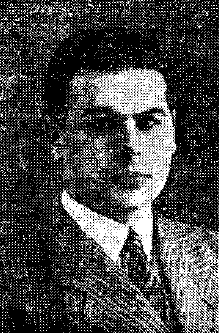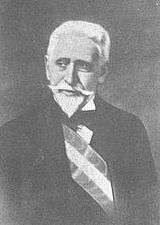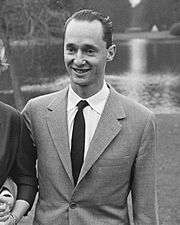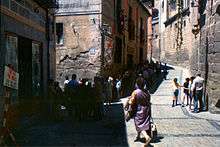José Luis Zamanillo González-Camino
| José Luis Zamanillo González-Camino | |
|---|---|
 | |
| Born |
José Luis Zamanillo González-Camino 1903 Santander, Spain |
| Died |
1980 Madrid, Spain |
| Nationality | Spanish |
| Ethnicity | Spanish |
| Occupation | lawyer, politician |
| Known for | Politician |
| Political party | CT, FET, UNE |
| Religion | Roman Catholicism |
José Luis Zamanillo González-Camino (Santander, 1903 – Madrid, 1980) was a Spanish Traditionalist/Carlist politician.
Family and Youth

José Luis Zamanillo González-Camino was born to a bourgeoisie Cantabrian family, son of José Zamanillo Monreal and María González-Camino Velasco. His father (and his grandfather) owned a pharmacy; he was a Catholic activist linked to the Integrist branch of the Carlist movement, locally organised in Centro Católico Montañés. As president of the board he managed La Propaganda Católica de Santander, the local publishing house issuing El Diario Montañés, the daily characterized by virulent antiliberal militancy. José Zamanillo Monreal has also co-founded the local Catholic trade union, Círculo Obrero de San José.
Many of Jose Luis' kinsfolk became Traditionalist activists. His cousin Marcial Solana González-Camino was a Carlist publisher and author; his brother Nicolás was the first president of the united Jaimist-Integrist Juventud Tradicionalista, while his sister Maria was a propagandist in the feminine branch of the movement, Las Margaritas. Jose Luis graduated in law from the Jesuit college of Orduña and obtained PhD in juridical science later on, though due to his political activities he had scarcely practiced. Married to Luisa Urquiza y Castillo, the couple had 10 children.
Republic

José Luis from his youth wrote to local periodicals and acted in Juventud Integrista. During the first days of the Republic he was already a locally recognized young activist. Following unification of Integrism with mainstream Carlism under the banner of the new claimant Don Alfonso Carlos, the Cantabrian grouping was reorganized in Centro Tradicionalista Montañés, with Zamanillo its vicepresident. He emerged as one of the most active leaders of the new organization, also vocal in the newly established Carlist periodicals, Gil Blas and Tradición. During the 1933 election campaign to the Cortes he represented the Traditionalists on the local Cantabrian Unión de Derechas Agrarias list and was comfortably elected.
In the mid-1930s Zamanillo cruised across the region opening new circulos. The strength of local Carlism was demonstrated in July 1934, when some 6 thousand activists, including 650 Requetés, amassed in Liébana. Zamanillo’s organizational skill impressed the new Traditionalist leader Manuel Fal Conde, himself the Andalusian ex-Integrist. Following massive reorganisation of the Carlist executive structures in late 1934 Zamanillo was appointed Delegado Nacional de Requeté; he spent most of 1935 building the nationwide paramilitary structures of the Traditionalist militia, hardly modernised since it had been built by Joaquín Lloréns.

Zamanillo lacked either military training or combat experience; he was rather entrusted with general organization, financing, logistics, recruitment, personal policy and overall guidance, military leadership left to general Varela. His first task was to build Frente Nacional de Boinas Rojas. Its technical objective was to detach the Requeté cells from local Carlist circulos and create a separate nationwide structure. The military aim was to inject more homogeneity, gain critical mass, enable planning above the tactical level and reinforce steerability. The political aim was to lessen the Carlist dependence on Navarre and enhance the position of national leadership. The task was carried out fairly smoothly in course of 1935. Zamanillo was also involved in logistics – on one occasion, he crossed the French-Spanish frontier with a load of 400 pistols – but his principal task was recruitment. The overall strength of the Requetés grew from 10,000 in late 1934 to 25,000 in mid-1936. Under Zamanillo’s guidance the Cantabrian Traditionalists were taking an increasingly corporative and authoritarian turn, paired with socially-oriented rhetoric. This stance drew them closer to the local Falange – actually, Zamanillo and the local FE leader Manuel Hedilla developed sort of friendship and the two parties pledged favorable treatment – but alienated other Rightist groupings. During the 1936 electoral campaign the Santander Carlists stood separately after being excluded from the Rightist coalition, which had previously promised a Traditionalist candidate on the list. The elections turned out to be insufficient with only 12,000 votes and Zamanillo lost his Cortes mandate.
Conspiracy and Civil War

Starting late 1935 Zamanillo held talks with potential partners in the anti-Republican rebellion, the Falange and Unión Militar Española. Early 1936 he co-drafted a stand-alone Carlists insurgency plan, abandoned later in the spring; having set up his HQ in Elizondo in the Pyrenees, he reverted to negotiations with the generals. As Fal's envoy he twice met general Mola in Pamplona, demanding that Carlist political conditions be accepted first. His intransigence amazed Mola, who commenced alternative negotiations with Navarrese leaders; the latter outplayed Fal and Zamanillo and convinced the claimant’s envoy, Don Javier, to authorise unconditional Carlist access to the coup.
As the hostilities broke out Zamanillo was flown together with Fal from southern France to the Nationalist zone. In August 1936 he entered Junta Nacional Carlista de Guerra, the new wartime executive Carlist structure headed by Fal and created partially to keep the Navarrese leadership in check. He became head of Sección Militar, though his direct duties covered only recruitment and propaganda; strictly military issues, theoretically under his control, were handled by Ricardo Rada.
During the summer Zamanillo echoed Fal, presenting the coup as a military-Carlist alliance between equals. In the fall of 1936 he acknowledged the military dominance, consenting that there might be a brief praetorian period before Traditionalist Monarchy is restored; he paid more attention to Don Javier’s assumption of the regency than to Franco’s elevation. In December 1936 Zamanillo was shocked when summoned to Nationalist headquarters in Salamanca and witnessed Fal forced out of the country; together with José María Valiente, Zamanillo became his key supporter later on.
.jpg)
As the pressure for unification mounted Zamanillo emerged as its most vehement opponent. Initially, during the meeting in Portugal, it seemed that pro-unification rodeznistas were in minority. Back in Spain, however, they mounted a counter-action and in a series of chaotic and tense meetings pushed their way through. When the Decreto de Unificación was announced Zamanillo, embittered and viewed unfavorably by Franco, joined the Requeté combat unit; according to some sources, he might have pondered armed resistance. Finally, as member of Tercio de Navarra battalion, he fought on the Basque front and took part in the siege of Bilbao.
Once Cantabria had been taken over by the Nationalists some young local Carlists started to form anti-unification resistance groups. The dissenters, dubbed Tercio José Luis Zamanillo, were eventually prosecuted; it is not clear to what extent Zamanillo was involved. He shuttled across the Nationalist zone, trying to preserve as much of the Requeté separate identity as possible. He was also helping individual Carlist soldiers compromised by clashes with the Falangists.
Opposition

After the Nationalist victory in 1939 Zamanillo maintained loyalty to the regent-claimant Don Javier and his Jefe Delegado Fal Conde, refraining from taking part in any official structures. In 1942 he entered Junta Auxiliar, an advisory body to Don Javier, and signed a document lambasting “a small group of collaborators and traitors”. Since the Francoist administration tolerated his activities with increasing difficulty, the declaration was probably the last straw. Zamanillo was detained in the Dirección General de Seguridad prison in Madrid, and then exiled under the security supervision in Albacete.
Upon his release in 1943 Zamanillo went on working to preserve the separate Carlist political identity; he signed Reclamación de poder, the Carlist call for restoration of Traditionalist Monarchy, delivered to Franco by general Vigón (and ignored),. As one of the organizers and speakers during the 1945 anti-Francoist Pamplona incidents Zamanillo was arrested again and spent some time behind bars; the case itself was closed as late as 1950. He was active in various semi-clandestine executive structures of the Comunión. As one of the most distinguished speakers he kept addressing Carlist feasts, like the 1947 Aplec de Montserrat or the 1948 Fiesta de los Mártires de la Tradición in Madrid. He stayed loyal to Don Javier also in 1952, when the latter decided to terminate the regency and announced his own claim to the throne.
Collaboration

Following the resignation of Fal in 1955 Don Javier created Secretaría Nacional, a new collective governing body, with Valiente its president and Zamanillo one of the three members. This marked the beginning of posibilismo, a new collaborative policy. Zamanillo, previously the right hand of Fal, found himself in an awkward position. Since the new strategy was welcomed with mixed feelings among the Carlists, his role was to provide the new leadership with credentials of loyalty to the Carlist identity and to tame the grumbling diehards. In the public statements from this period, like the speech delivered at the Montserrat rally in 1958, Zamanillo pursued the new strategy declaring that the Carlists can not abandon the spirit of July 18, though they were not happy with the spirit of April 14.
Key ally against the internal opposition turned out to be the son of Don Javier, Carlos Hugo, presented to the Carlists in 1957. The prince moved from France to Madrid, working closely with Zamanillo and Valiente; in 1961 he set up his Secretaría Política. The joint team of old and new leaders masterminded the collaborative strategy, which included accepting positions in Movimiento Nacional and mandates in the Francoist quasi-parliament. As a result, in 1961 Zamanillo resumed his career of a deputy. In 1962, when Franco allowed the formation of Requeté ex-combatant organisation, Zamanillo became its leader. The same year he was personally admitted to Franco, who declared that all monarchical options were still opened and concluded by suggesting “keep on working, gentlemen”.

Over time Zamanillo grew skeptical of the young prince and began suspecting the hugocarlistas of pursuing a hidden agenda. As the tension grew, he became more and more confident that Carlos Hugo was toying with dangerously Leftist ideas. In 1962 Zamanillo addressed Don Javier with the letter, accusing his son of being a subversive revolutionary. The aging claimant, however, gave way to Carlos Hugo. As a result, Zamanillo resigned first from all posts in the Comunión structure (1962) and then from the Requeté leadership (1963). Since at that time he led the faction stressing a monarchist rather than a royalist approach, vaguely suggesting a new Caspe accord, he lost some supporters also among the sworn javieristas. Early 1964 the Massó-led hugocarlistas got him expelled from the Comunión altogether, the official reason quoted was his over-committing to Francoism.
Within Francoism

Following his Cortes tenure in 1961-1964 Zamanillo was re-appointed from the Consejeros Nacionales pool in 3 successive turns of 1964, 1967 and 1971. Embittered by his expulsion and reinforced in his rancor towards the disguised Marxist plot, during his parliamentary activities he drew closer to the hardline Falangist core of José Antonio Girón and Raimundo Fernández-Cuesta, gradually taking even more extreme positions of Blas Piñar. He was appointed to Junta Politica in 1964. Facing rectifications of the system pushed through by the Francoist reformists in the second half of the 1960s, be it relaxation of the Press Law, the new Organic Law or amendments to the Labour Law, Zamanillo tended to side with the most conservative section of the procuradores. The project which attracted his particular enmity was the new Law on Religious Freedom, adopted in 1967, as he claimed that it favored 30 thousand Protestants at the expense of 30 million Catholics.
Disillusioned about the Carlist claimant Don Javier, considered incapacitated by the camarilla of his son, in 1969 Zamanillo accepted Juan Carlos de Borbón as the future king, thought to be a better option than his opportunist father. In 1972 he was nominated member of Consejo de Estado, a consultative body deprived of any power and functioning mostly as a prestigious perk for political retirees. In late 1973 Zamanillo participated in one of the last hardline attempts to seize more control, the Comisión Mixta Gobierno-Consejo Nacional, dissolved soon afterwards by Carrero Blanco.
Transition
In mid-1970s Zamanillo formed part of the bunker, the diehard group determined to preserve as much of the Francoist structure as possible. He opposed the transitory project of Adolfo Suárez and tried to cancel the reformist edge of Ley para la Reforma Política. Unsuccessful, in 1976 he was one of the deputies who voted against the law, refusing to commit what is dubbed “suicide of the Francoist Cortes” and advocating later a “no” vote in the 1976 referendum. He also ventured to muster public support by co-founding Fundación Nacional Francisco Franco in 1977. In 1975 Zamanillo joined Valiente in Unión Nacional Española, intended as a broadly based conservative monarchist party. During the 1977 elections to the Constituent Cortes UNE formed part of the Rightist Alianza Popular. Zamanillo stood in his native Santander, but failed in his bid for the Senate. Soon afterwards Unión Nacional Española got divided over the draft democratic constitution; Zamanillo represented the hardline group against the more acquiescent faction of Gonzalo Fernández de la Mora. He left UNE in 1978.

Still regarding himself member of the Carlist movement, Zamanillo sided with the younger son of Don Javier, Don Sixto, who in 1975 challenged his brother by re-affirming the Traditionalist ideario. It is not clear to what extent he engineered the bloody confrontation between sixtinos and hugocarlistas during the Montejurra aplec in 1976; formally accused of complicity, the case was eventually dropped. In 1977 Zamanillo registered an orthodox Carlist organization, Comunión Tradicionalista, which joined the coalition Unión Nacional that earned a seat in the Spanish Parliament in 1979, although the coalition broke up in 1982 and the grouping alone could hardly take off the ground. At that time he lost any illusions about Juan Carlos. Once Don Javier died in 1977 and Carlos Hugo abandoned his claim to the throne in 1979, Zamanillo was increasingly inclined towards the regency of Don Sixto as a proper Carlist dynastical solution.
See also
References
- Julio Aróstegui, Eduardo Calleja, La tradición recuperada: El requeté carlista y la insurrección, [in:] Historia Contemporanea 11, 29-53
- Martin Blinkhorn, Carlism and Crisis in Spain 1931-1939, Cambridge 1975, ISBN 9780521207294
- Francisco Javier Caspistegui Gorasurreta, El naufragio de las ortodoxias. El carlismo 1962-1977, Pamplona 1997, ISBN 8431315644
- Eduardo Gonzales Calleja, Contrarrevolucionarios, Madrid 2011, ISBN 9788420664552
- Jeremy Macclancy, The Decline of Carlism, Reno 2000, ISBN 9780874173444
- Manuel Martorell Pérez, La continuidad ideológica del carlismo tras la Guerra Civil [PhD thesis], Valencia 2009
- Manuel Martorell Pérez, Retorno a la lealtad; el desafío carlista al franquismo, Madrid 2010, ISBN 9788497391115
- José Luis Rodríguez Jiménez, Reaccionarios y golpistas. La extrema derecha en España: del tardofranquismo a la consolidación de la democracia (1967-1982), Salamanca 1994, ISBN 9788400074425
- Julian Sanz Hoya, De la resistencia a la reacción: las derechas frente a la Segunda República, Salamanca 2006, ISBN 8481024201
- Mercedes Vázquez de Prada, Juanistas y carlistas: el intendio de unión monarquica de 1957, [in:] Aportes 57, XX, 1/2005, pp. 77–93
- Mercedes Vázquez de Prada, El nuevo rumbo político del Carlismo hacia la colaboración con el regimen (1955-1956) [in:] Hispania LXIX / 231, pp. 179–208, ISSN 0018-2141
- Mercedes Vázquez de Prada, El papel del carlismo navarro en el inicio de la fragmentación definitiva de la comunión tradicionalista (1957-1960), [in:] Principe de Viana 254, Pamplona 2011, ISSN 0032-8472
- Aurora Villanueva Martinez, Los incidentes del 3 de diciembre de 1945 en la Plaza del Castillo, [in:] Principe de Viana 212, Pamplona 1997, pp. 629–650
External links
- Zamanillo on Geni
- Zamanillo in the "Gallery of Traitors" by a hugocarlista historian
- Cantabrian politics in 1930s
- Historical Index of Deputies
- Requete buildup
- Requete buildup
- Carlism 1931-1937
- Zamanillo and anti-republican conspiracy
- Civil War in Cantabria
- Zamanillo and Junta Nacional de Guerra
- early Francoism in Cantabria
- Carlism after 1937
- Carlism struggling to preserve identity under Francoism
- Pamplona 1945 incidents
- Carlist collaborative turn of 1955-6
- Zamanillo at Montserrat 1958
- 1957-1960 breakup in Carlism
- Carlism after 1958 by hugocarlistas
- Zamanillo admitted to Franco
- Zamanillo and Law on Religious Freedom
- Zamanillo and late Francoism
- Zamanillo and the transition
- Zamanillo trying to derail Ley para la Reforma
- Zamanillo in the press (mostly 1970s)
- paperclip on Zamanillo and Montejurra 1976
- divisions in UNE
- struggle for power in UNE
- Zamanillo registering Communion Tradicionalista in 1977
- Carlism according to hugocarlistas
- Carlism according to sixtinos
- Vizcainos! Por Dios y por España; contemporary Carlist propaganda